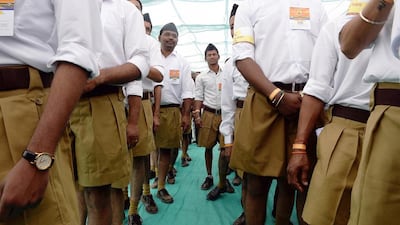NEW DELHI // India’s largest Hindu nationalist organisation has introduced a series of measures to attract more youngsters into its fold – including getting rid of its much-mocked shorts.
The Rashtriya Swayamsevak Sangh (RSS), the right-wing group that is the ideological parent of the ruling Bharatiya Janata Party (BJP), has changed its uniform to instead include khaki trousers. For the first time in the group’s 91-year-history, its members will not have to wear khaki shorts – an item of apparel that came in for frequent mocking because of their poor fit upon ageing or portly leaders.
Photographs from RSS rallies often showed men of various ages wearing these badly tailored shorts. They were pleated and flared, and they rode either too high on their wearers’ hips or below their bulging bellies.
The shorts even gave rise to the term “chaddiwala” – literally, “underwear fellow” – which is often used derisively by opponents of the RSS to describe its members.
"There's something more dignified about trousers," one RSS official, who asked not to be named, told The National. "If we want to get new members, we should have a uniform they will be comfortable with."
The change comes at a time when the RSS is aggressively trying to appeal to the younger segments of India’s population of 1.2 billion. Other initiatives include: school and college programmes that champion RSS principles; a more streamlined online membership application process; and membership drives targeting young professionals in India’s engineering and IT sectors.
The decision to incorporate trousers into the uniform was taken during an RSS meeting in March. The new uniform went on sale at the organisation’s headquarters in Nagpur on Monday. In the initial phase, roughly 700,000 pairs of trousers, priced at 250 rupees (Dh13.7) apiece, will be distributed to RSS offices around the country this month.
The RSS members are volunteers, and the organisation does not keep a list of the people who join its ranks. Estimates of its membership range from four million to six million.
The success of the BJP in the 2014 parliamentary election and the popularity of prime minister Narendra Modi – a long-time RSS member – have boosted the organisation’s fortunes.
The number of RSS chapters – known as shakhas – across India rose from 51,332 in March last year to 56,859 in March this year, the fastest rate of growth in the group’s history, according to Alok Kumar, an RSS leader in Delhi.
At a time of such rapid development, “the uniform has become out of date”, Mr Kumar said.
The RSS attire is a reminder of the group’s history and of its quasi-paramilitary nature.
Founded by Keshav Hedgewar in 1925, the RSS was simultaneously a revolutionary outfit that claimed to be committed to fighting British rule – although some say it was in fact cosying up to the British – and a body attempting to convert India into a Hindu nation.
Many early RSS leaders openly professed admiration for the fascist parties of Europe, especially those of Adolf Hitler and Benito Mussolini. The first RSS uniform, comprising khaki shirts, shorts and caps, a leather belt and heavy black shoes, resembled the militaristic attire of Mussolini’s Black Shirts.
The shorts also made practical sense. Throughout its history, the RSS has conducted physical exercise drills in its shakhas, believing in a muscular, militant form of Hinduism. Wearing shorts made it easier to participate in these drills.
Through the nine decades of the RSS’ existence, the uniform has changed only five times. In 1930, the khaki cap was replaced by a black cap. A decade later, the khaki shirt gave way to a white shirt.
In 1973, the RSS threw out its original heavy black shoes and prescribed black shoes that weighed less. And five years ago, the leather belt yielded to a belt made of canvas.
The shorts, however, have always been a staple of the RSS uniform, even though members of its affiliated international organisation– the Hindu Swayamsevak Sangh – have long been permitted to wear trousers.
ssubramanian@thenational.ae

